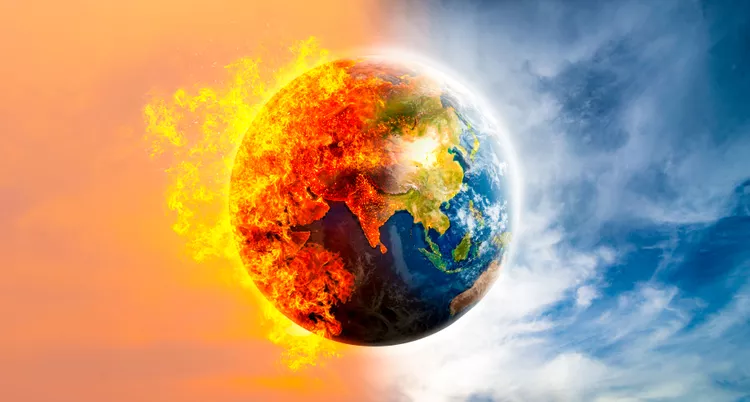India is grappling with a growing threat that demands immediate attention – the alarming rise in heatwaves. Questions are arising about the country’s readiness to cope with these increasingly frequent and intense extreme weather events. The tragic incident that unfolded in Kharghar, Navi Mumbai, in April 2023, where 14 lives were lost due to heatstroke during a government ceremony, serves as a stark reminder of the urgent need for a comprehensive and effective heat emergency plan in India.
Rising Temperatures: A Grim Reality
India has been witnessing a steady increase in temperatures, with February 2023 being marked as the hottest February on record in the country’s meteorological history. Although the monthly average temperatures during March and April were above normal, they did not reach exceptionally high levels due to sporadic thundershowers that occasionally provided some relief. However, the real concern lies in the fact that daily maximum temperatures consistently exceeded normal levels on multiple occasions, exacerbating the severity of the heat.
On the fateful day in Kharghar, meteorological observatories recorded maximum temperatures ranging from 34 to 38 degrees Celsius, coupled with relatively high humidity levels, which further intensified the heat’s impact. High humidity can disrupt the body’s ability to regulate its internal temperature, resulting in heatstroke and, in severe cases, multiple organ failure.
Tragedy Strikes Vulnerable Communities
It is important to note that the tragic fatalities in Kharghar cannot be attributed solely to the elevated temperatures and humidity. Instead, they were exacerbated by the prolonged exposure of vulnerable sections of the population to extreme conditions. Most of the victims were middle-aged to elderly women who spent hours commuting and then sat in a densely packed open ground for an extended period without access to water or adequate sanitation facilities. This tragedy underscores the critical importance of implementing fundamental precautions and preparedness measures.
Understanding Heatwaves: A Consequence of Climate Change
Heatwaves in India are typically caused by the descent of hot, dry air from the upper atmosphere, forming a stifling heat dome over the region. This phenomenon is further exacerbated by climate change, resulting in more frequent, intense, and extended heatwaves, especially in the arid northwest Indo-Pakistan region. This region, inhabited by approximately 760 million people, is particularly susceptible to record-breaking heatwaves, often exceeding 40 degrees Celsius, particularly in April and May.
The geographical scope of the heatwave-prone zone spans multiple states in India. Between 1971 and 2019, heatwaves claimed the lives of about 17,362 people in the country, averaging around 350 lives lost each year. Climate change has amplified the severity of these heat extremes, with future projections indicating a potential sixfold increase in heatwave frequency by 2060. This alarming trend raises significant concerns for the growing vulnerable population in the region, which is estimated to reach 1 billion by 2050.
Urban Heat Islands: Adding to the Challenge
Urban heat islands, a phenomenon where cities become several degrees hotter than their surrounding rural areas due to heat-absorbing infrastructure, have further exacerbated rising temperatures. Inadequate urban planning, construction practices, and a lack of green spaces in cities contribute to the intensification of urban heat islands.
The Broader Impacts of Heatwaves
The impacts of heatwaves extend beyond health risks, encompassing widespread wildfires, crop failures, water shortages, and increased electricity demand. These compound extreme events, driven by the intersection of climate change and land use changes, present multifaceted challenges to mitigation and adaptation efforts.
Preparation and Action: A Way Forward
To address the escalating threat of heatwaves, India’s Meteorological Department provides timely heatwave warnings and forecasts to cities and districts. These forecasts, boasting an accuracy rate of 80-90% for the next two days, serve as the foundation for local governments to prepare and issue yellow (watch), orange (be prepared), or red (take action) alerts based on the severity of the impending heatwave. Several cities and states have proactively initiated their own heat action plans, collaborating with disaster management agencies and health departments to safeguard their populations.
Nevertheless, these localized plans are only the beginning of what is required to confront the long-term and intensifying challenges posed by heatwaves. India must implement comprehensive policies that prioritize the redesign of cities to incorporate open spaces and greenery to facilitate the rapid dissipation of excess heat. These policies should also integrate heat emergency plans into educational curricula and workplace policies, equipping individuals to effectively manage heat emergencies and safeguard their health and well-being.
A Call for Proactive Measures
The tragic incident in Kharghar serves as a poignant reminder of the critical importance of proactive measures and comprehensive policies aimed at protecting vulnerable populations from the growing menace of heatwaves. By implementing necessary precautions and robust policies, India can strive to prevent such tragic events and ensure the safety and well-being of all its citizens in the face of extreme heat events. The time for action is now, as the country braces for a future where heatwaves are not just an anomaly but a persistent and intensifying threat.
Author
-

Dr. Roxy Mathew Koll is a Climate Scientist at the Indian Institute of Tropical Meteorology. He did his Ph.D. in Ocean and Atmospheric Dynamics from Hokkaido University, Japan. Dr. Koll is a Lead Author of the IPCC Reports and the former Chair of the Indian Ocean Region Panel. He actively collaborates with citizen science networks, local governments, and media to bring science to society.



